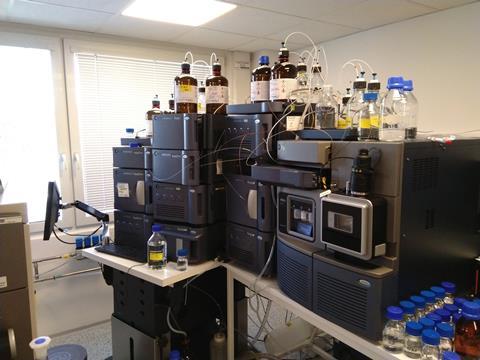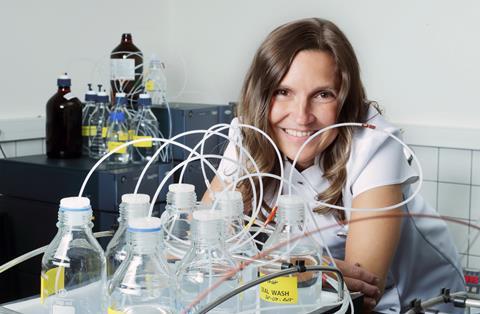Supercritical Fluid Chromatography (SFC) is a chromatography technique with a lot of promise, but it has yet to gain popularity. ‘Much of what you normally can’t separate with LC, you can separate with SFC.’

‘Supercritical fluid chromatography (SFC, ed.) and ‘ordinary’ fluid chromatography (LC, ed.) have a lot in common, but the big difference is the composition of the mobile phase,’ says Lucie Nováková, professor in analytical chemistry at the Faculty of Pharmacy in Hradec Králové, Charles University in the Czech Republic. SFC has been around since the 1960s, but has gained renewed interest in recent years.
In SFC, the mobile phase consists of supercritical carbon dioxide. When you apply high pressure and the right temperature to CO2, the separation between the liquid and gas phase disappears. ‘But elution with supercritical CO2 is quite limited’, Nováková continues. ‘That is why you add an amount of organic component, usually methanol or ethanol when it comes to cosmetics. The consequence is that you don’t work supercritically, but subcritically, but you keep the favourable properties.’
‘You have a bit of the advantages of both gas and liquid chromatography.’
Ken Broeckhoven, professor of chemical separation technology at the Free University of Brussels, agrees it’s a very interesting technique for preparative separations. ‘You need far fewer solvents and you can separate substances that are water sensitive’, he says. ‘And after the separation, you can just let the CO2 evaporate, leaving your compound concentrated in methanol. Most of these preparation systems also allow you to recycle CO2.’ Furthermore, supercritical CO2 is not very viscous and its high density allows many substances to dissolve in it. ‘You have a bit of the advantages of both gas and liquid chromatography.’

Favourite keyword
Nováková secretly finds the complementarity of LC and SFC the most interesting aspect. ‘When comparing LC and SFC, complementarity is my favourite keyword’, she explains. ‘The separation mechanisms are different in both techniques, and thus you can solve difficult separations of one with the other.’ The obtained information can then be used for, among other things, omics research and screening analyses, for example in doping. Broeckhoven adds: ‘Separations with SFC are orthogonal to LC; there is no direct correlation in the separation between the two techniques, so much of what you cannot normally separate with LC, you can separate with SFC.’
So why has a technique with so many advantages still not made it into mainstream science? Broeckhoven: ‘That used to be mainly due to reproducibility, but now it’s more about the transferability of the methods from lab to lab. Each instrument works a little differently, and there are a lot of variables. Think of the CO2-cosolvent ratio, back pressure, column and tube length, et cetera.’ The method is also much less ‘idiot proof’ than ordinary LC. ‘You have to think about many more things and that scares researchers a bit. You really have to know what you are doing.’
‘People doubt SFC. As a result, there is less investment’
But once you get the hang of it, an intriguing world opens up for you. ‘As an analytical chemist working at the Faculty of Pharmacy, I have done a lot of research on the usefulness of SFC in pharmaceutical analysis, including chiral separations and validation of methods in pharmaceutical quality control’, Nováková says. Furthermore, we analysed lipophilic vitamins in biological materials, since with SFC you can separate the often different isomers of such vitamins very well. In addition, SFC helps the field of ‘lipidomics’ at all: it provides the fastest separation of the lipid classes so far.
These days, Nováková’s focus is on the analysis of plant materials and more fundamental aspects. Nováková: ‘We’re optimising the coupling of SFC to mass spectrometry. We also study the effect of column history on analytical results.’ There are still quite a few fundamental things that are not well understood in SFC, according to Broeckhoven. ‘Take the pressure build-up, for example. In LC, the column heats up due to the high pressure, but a gas then cools down’, the Flemish professor explains. ‘The problem with SFC is that the temperature can rise as well as fall, depending on the conditions. A supercritical fluid is complicated, it can go either way.’

Fascination
Besides fundamental issues, there are also practical issues that are not yet favourable for SFC. Most SFC instruments currently run at only 400 bar, whereas with an LC you can go up to 1500 bar’, continues Broeckhoven. That pressure can, however, be increased, Broeckhoven knows. In our lab, together with a producer, we developed an LC unit with which we could go up to 1200 bar in SFC, and that went very well.’
There are also sometimes problems with the systems themselves. The separation in the column is then fine, but the other parts of the machine reduce some of that separation. Everything must also be much more robust in order to maintain the supercritical state. Broeckhoven: ‘People doubt SFC. As a result, there is less investment, which means there are no incentives for further development. It is a vicious circle that repeats itself in waves. ‘
Nováková hopes that SFC will become a more widespread technique, although she realises that this could be a difficult process. ‘Of course, the pressure limits that apply now throw a spanner in the works. But you could partly solve that by using commercially available core-shell particles in the column, for example. According to Nováková, the solution to all problems with SFC – and with chromatographic science as a whole – is very simple: ‘Stay Fascinated by Chromatography!’ she says laughing.
SFC and cannabis
The legalisation of cannabis in the US is making research into potential drugs much easier, and SFC can play a role in this, Ken Broeckhoven believes. Determining quality, concentration and related matters is very important, also for the medical side. The non-hallucinogenic components can be eluted selectively from the plant using SFC. In Belgium, there has been a case for several years where the condition of a young girl with severe epilepsy was significantly improved by certain components of cannabis oil. However, cannabis oil is still illegal, because the addictive substance tetrahydrocannabinol is difficult to separate from the desired component cannabidiol. SFC can offer a solution in this case, as was mentioned in the SFC-special of Analytical Sciences Advances. This article, like the rest of this special, is open access. That also allows people from the industry to read it, according to Broeckhoven. You can find the SFC-special here: tinyurl.com/SFC-special












Nog geen opmerkingen